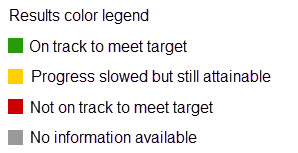Percent Arterial Bike Network Crossings Completed
Desired Result: Above Target

Metric Definition
This measures arterial bike crossing improvements implemented since the adoption of the 2014 Bicycle Master Plan. Arterial bike crossings are areas where a bicycle route crosses a major street. Crossing at such intersections can be uncomfortable and a barrier to bicycle travel. Improvements include things like widened ramps and waiting areas, overhead signals, pavement markings and signage to guide bicyclists. Improving bike crossings helps people bike safely, encouraging more ridership thus indirectly decreasing emissions. An increase in bike crossing improvements is a positive trend. Data is supplied by the City of Fort Collins.
Why Is This Important?
Arterial bike crossing improvements are the foundation of the City’s recommended 2020 low-stress bicycle network, which aims to increase the percentage of people who bicycle in Fort Collins to 20% while reducing bicycle-related crashes. Measuring completion of these projects helps track the City’s progress toward providing a bicycle network that is attractive and safe for all.
City Organization Impact on Performance
– The 2014 Bicycle Master Plan establishes a prioritized list of projects, and a dedicated infrastructure tax approved by voters is applied to project completion each year. Performance is evaluated by the City quarterly.
Benchmark Information
Fort Collins is consistently identified as one of the most bicycle friendly communities in the country, and the city’s bicycle commute mode share is one of the highest in the nation. The City’s bikeway network and ongoing infrastructure advancements are a large part of these recognitions and metrics.